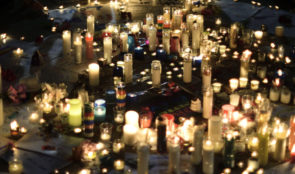“If only it were all so simple! If only there were evil people somewhere insidiously committing evil deeds, and it were necessary only to separate them from the rest of us and destroy them. But the line dividing good and evil cuts through the heart of every human being. …It is impossible to expel evil from the world in its entirety, but it is possible to constrict it within each person.”
They Never Had A Chance
Theresa Graybeal never had a chance. On a rainy February night in 1978, she drove to a Modesto Kmart to buy a sack of dog food, and when she got back to her car, four people surrounded her, forced her back into the car, and then drove to Fresno. There, they robbed her of $32, and then, after going to a bar, headed to Calwa, where they stopped the car and got out. Graybeal got out too. Suddenly, for no apparent reason, somebody shot her in the head. She was 22 and recently married to David Graybeal, who worked at a nearby food factory.
“He knows he did it, and he’s just trying to get out of it,” said her father-in-law, Wayne Graybeal of Ceres, California. “He was a bad guy, and I don’t know why he’s alive.”
“I wish they would just do what they have to do to him so he’s not still alive breathing the same air as me. That man needs to die,” said Graybeal.
That man was Douglas Ray Stankewitz. At the time, Stankewitz insisted he did not kill Theresa Graybeal, and he has been saying that ever since the group was first arrested for Graybeal’s robbery, kidnap and murder in 1978. He has said it through two guilty verdicts and three separate appeals, once in California Supreme Court and twice in federal appeals courts. And he is still insisting on his innocence today. Stankewitz, at 57, is now the oldest resident of San Quentin’s death row, where he has lived for 38 years.
Stankewitz never had a chance either. He was born in 1958 to a Mono-Chukchansi Indian mother and a Polish-American father, both alcoholics, living on the impoverished Big Sandy Rancheria outside of Fresno, the sixth of eleven children. His mother, Marion, drank heavily throughout her pregnancy, and Douglas was likely born with fetal alcohol syndrome. Both parents beat him so badly and routinely that before Stankewitz was a year old, he had been admitted to the emergency room three times. When he was 6, he was picked up wandering the streets, injured and confused. His mother was jailed for beating him, and Stankewitz spent most of the rest of his first 18 years in 22 separate foster homes, in Napa State Psychiatric Hospital — where he was raped — in Youth Authority prisons, and finally in jail. At the time of Graybeal’s murder, Stankewitz had been out of jail for only two months.
It is unlikely that either the jailer or assistant district attorney knew that Stankewitz’ grandfather was a holy man in the Chuclchansi religion.
Although Stankewitz’s first trial resulted in a death sentence, the California Supreme Court overturned the conviction. For his second trial, the trial court appointed ex-judge Hugh Goodwin — who had earlier become an ex-judge by refusing to accept the separation of church and state in his court — as Stankewitz’s attorney. Under California law, Goodwin had a duty to tell the jury about Stankewitz’s brutal childhood and his diagnosis of borderline mental incapacity. Instead, Goodwin called a jailer and an assistant district attorney to the witness stand to opine as to whether a person could truly “reform” without receiving God into his life. Under cross-examination, the prosecutor asked these witnesses if they had any reason to believe Stankewitz had invited God into his life. Each stated that he did not. Stankewitz, then only 19, was found guilty and sentenced to death — the first man condemned to die since the death penalty’s reinstatement in 1977.
How Did We Get Here? Californians Reinstate the Death Penalty
Californians have been arguing about the death penalty for 44 years. In February 1972, the California Supreme Court ruled that the death penalty constituted “cruel and unusual punishment” and was, therefore, unconstitutional. In November 1972, California voters responded by passing a ballot measure amending the state constitution to declare that the death penalty was not cruel and unusual punishment. In 1973, the California state legislature followed with a mandatory death penalty regulation, which the California Supreme Court again found to be unconstitutional three years later in 1976, citing the U.S. Supreme Court decision in Woodson v. North Carolina, which held that mandatory death penalty statutes were unconstitutional.
Less than a year after the state’s Supreme Court decision, the California legislature tried to restore the state’s death penalty with new legislation. Governor Jerry Brown vetoed the bill saying, “Statistics can be marshaled and arguments propounded but at some point each of us must decide for himself what sort of future he would want. For me, this would be a society where we do not attempt to use death as a punishment.”
The California legislature overrode Gov. Brown’s veto, and the death penalty was reinstated in 1977.
That same year, the legislature also added a sentence of life without the possibility of parole (LWOP) to the California penal code. And in 1978, the voters passed Proposition 7, which increased the number of crimes eligible for the death penalty to 28. The “special circumstances” under which the death penalty could be imposed included the killing of “special” victims, such as government officials, law enforcement officers, child victims of sex crimes, and witnesses; those with prior homicide convictions, those affiliated with gangs, and non-intentional killings that occurred during the commission of certain felonies. Prop 7 did, however, grant the condemned an automatic appeal to the Supreme Court of California.
In 1986, California voters threw out three members of the state Supreme Court because of their refusal to apply the death penalty. And in 1992, the state carried out its first execution since 1967, killing Robert Alton Harris for the murder of two teenaged boys in San Diego. But in 2006, a federal judge blocked the execution of murderer Michael Morales, based on the potential of cruel and unusual punishment indue to the controversial drugs used in the state’s lethal injection. There has not been an execution in California since 2006.
In 2012, a coalition of anti-death penalty activists — including a retired San Quentin warden, law enforcement officers, members of murder victims’ families, and wrongly convicted ex-prisoners — put Proposition 34 on the California ballot. Prop 34 would have abolished the death penalty and substituted it with a sentence of Life Without Possibility of Parole (LWOP), and would have required those sentenced to LWOP to work to pay restitution to victims’ families. It also mandated $30 million per year for three years for police departments, to support police efforts to solve open murder and rape cases. Prop 34 was voted down that year by the people of California, 52% to 48%.
Since Stankewitz’ arrival on death row in 1977, the state of California has condemned more than 900 people to death. Of these, 118 have died of suicide, natural and other causes — 48 of them while waiting for state and federal courts to hear their direct appeals or their habeas corpus petitions.
Of the 747 death row inmates still living, 126 stand convicted of torture before murder, 173 of killing children and 44 of murdering police officers.
To date, only 18 of the 747 have completed both their state and federal appeals processes. Many are still awaiting appeal or are in the midst of an appeals process — with a typical appeal taking anywhere from 15 to 25 years to resolve and the appeals process costing taxpayers tens of millions of dollars each year. In fact, the current backlog of unresolved cases makes California’s death row the largest in the western hemisphere.
This brings us to 2016 and two new competing ballot propositions in California. Proposition 62 would abolish the death penalty, and replace it with LWOP. Like Prop 34 before, Prop 62 would apply retroactively to currently condemned inmates, and require those sentenced to LWOP to work to pay restitution to victims’ families, at the rate of 60% of wages earned while working in prison. It would also direct appeals in all first-degree murder cases to the California appellate courts with a mandatory resolution time of 3 to 5 years (instead of the current 15 to 38 years it takes to render a verdict).
According to the California Legislative Analyst’s office, abolition of the death penalty will save the state $150 million annually, beginning immediately upon enactment.
Proposition 66, on the other hand, would maintain the death penalty but accelerate its application so that condemned prisoners’ legal challenges to their death sentences would occur within five years of sentencing. It would also require the trial judges who had originally handed down the death penalty verdicts to hear the initial appeals from the sentence (known as habeas corpus petitions), assuming those judges are still on the bench.
Any adverse decisions would head straight to the California appellate courts, and finally, if necessary, to the California Supreme Court. Rather than the state Supreme Court, the initial trial courts would be required to appoint the habeas attorneys. To address judicial backlog, Prop. 66 would lower the required qualifications for attorneys representing death row petitioners in order to increase the number of attorneys, while still “ensuring competent representation.” In this way, Prop 66 intends to expand the appellate bar by including prosecutors, for example, and by forcing criminal appellate attorneys to either take death penalty appeals or face expulsion from the court’s appointment list.
Prop 66’s true fiscal impact is unknown but the California Secretary of State estimates that it will add tens of millions of dollars annually for initial implementation, even before federal appeals and their additional costs are factored in.
We All Agree Up To A Point But…
Proponents of both Prop 62 and Prop 66 agree that the current system is broken, untenable and dysfunctional, but they disagree on how best to fix it. Hundreds of millions of taxpayer dollars have already been spent on decades of appeals in state and federal courts. The 13 prisoners executed in California since 1978 cost taxpayers an average of $384 million per inmate because of constitutionally guaranteed appeals and special accommodations — 18 times the cost of litigating life sentences.
But Prop 66 creates a host of other problems for California courts, attorneys and 58 counties.
Each of these counties is home to a superior court, the trial court level at which most criminal cases are first heard. By requiring the original trial courts (where the death penalty verdicts were handed down) to hear the appeals, Prop 66 foists the costs of the appeals of current (and future) condemned inmates back onto the 58 counties.
In short, Prop 62’s solution is to abolish the death penalty, while Prop 66’s solution is to fast track it and hopefully save money along the way.
At present, state taxpayers foot the bill for these appeals. Under Prop 66, these costs would be shouldered by the counties. In a poor county, one death penalty appeal alone could consume an entire budget. In 2013, for example, the price of one El Dorado County death penalty case was more than $1 million. The county’s entire contingency budget for that year was $3.4 million.
Nearly half (47.9%) of the death penalty cases come from three counties — Los Angeles county currently has 23 death sentences, Riverside county, 89, and San Bernardino county, 40. The current shortage of superior court (county) judges is gargantuan. Each of Riverside county’s 76 superior court judges, for example, has a current case load of more than 5,570 filings. California estimates that it will need to hire 51 more judges in Riverside county alone. Prop 66 puts the work and the fiscal load back on the county judges and county coffers, which are already dramatically overburdened.
The state Supreme Court cannot reduce its current backlog of death penalty cases so long as new cases are added to its docket every year. In 2010, 77 death penalty appeals and 89 habeas corpus petitions, all fully briefed, were on the court’s calendar, with a forecasted two-year delay between briefing and oral argument. The situation remains unchanged in 2016, due in part to the lengthy process of appointing appellate counsel.
There is also the issue of pay for those attorneys representing death row petitioners. Under current law, the California pays private practice attorneys who take death penalty appeals at the rate of $145 per hour, with different caps for cases of differing complexity, age , and circumstances. But in fact, many attorneys do not get their costs reimbursed, and wind up making less than $35 per hour.
Under current law, the state Supreme Court appoints attorneys who have been approved by the Habeas Corpus Resource Center (HCRC). The HCRC was established in 1998 as part of California’s judicial branch, with a mission to represent indigent men and women condemned to death in state Supreme Court and federal habeas proceedings, and to provide training and support to private attorneys who are appointed to represent indigents in capital cases. Prop 66 would take that qualifying authority away from HCRC, and give it back to the state Supreme Court. Unfortunately, this move creates a violation of the American Bar Association’s guidelines for death penalty representation, which have been established by capital defense experts, including lawyers, judges, scientists, sociologists and doctors. HCRC Guideline 3.1.B states that “it, and not the judiciary or elected officials, should select lawyers for specific cases.”
Prop 66 also proposes to force attorneys currently in the state Supreme Court panel of attorneys to take death penalty cases or face removal from the state Supreme Court panel. This requirement creates a couple of additional problems. Forcing lawyers to take cases for which they know they are not qualified can lead to those attorneys litigating against Prop 66, if it passes.
Attorneys could argue that they legally cannot be forced to render incompetent legal assistance to clients whose lives are at stake, thereby opening themselves to state bar discipline for incompetent practice as well as appellate charges of ineffective assistance of counsel.
Meanwhile, death row inmates awaiting counsel could claim, if nobody stepped up to represent them, that they were entitled to representation equally as competent as other death row appellants. Rather than speed the legal process up, Prop 66 would create a legal morass prior to any appeals trial even getting started.
Counting The Costs
Prop 66 offers Californians the medieval prospect of carrying out an unknown number of executions each year for several years — assuming the lethal injection problem gets solved — in order to fulfill the death penalties of the 747 people currently on death row. Voters are still mostly undecided, according to recent polls.
In a September 8-11 Survey USA poll, Prop 62 was headed for defeat, trailing by 16 points. But as of September 21, according to a Field-IGS poll, 48 percent of likely voters were in favor of Prop 62 or abolishing the death penalty and replacing it with LWOP. 37 percent opposed it and 15 percent were undecided. while 42 percent were still undecided about Prop 66, or keeping the death penalty with improvements. That’s a lot of change in 10 days.
In general, people don’t like murderers or those convicted of murder. In general, among humans, revenge is a strong motivator — but so is empathy.
Prop 66 may bring peace of mind to some family members of murdered victims. But it will not resolve the issue of execution of the innocent, nor address the racial disparities in death penalty convictions in California. Ultimately, California voters must decide whether we’d like to create a society that finds state execution ethical or a society that does not accept execution as a just form of punishment.
-Martha Ture
Worth your time
- Non Gamstop Casinos UK
- Best Non Gamstop Casinos 2025
- Non Gamstop Casinos UK
- Non Gamstop Casinos UK
- Casinos Not On Gamstop
- Casinos Not On Gamstop
- Casino Not On Gamstop
- Casino Italiani Non Aams
- Online Casino Canada
- Non Gamstop Casinos Uk
- Best Non Gamstop Casinos
- Meilleur Casino En Ligne France
- Casino Sites Not On Gamstop
- Non Gamstop Casino Sites UK
- Casino Online Non Aams
- Casino Sites Not On Gamstop
- Non Gamstop Casinos
- Meilleur Casino En Ligne France
- Meilleur Casino En Ligne Francais
- Casino Sites Not On Gamstop
- Non Gamstop Casinos UK
- Casinos Not On Gamstop
- Migliori Siti Casino Non Aams
- Meilleur Casino En Ligne
- Casino Non Aams
- Meilleur Casino En Ligne Belgique
- Siti Non Aams
- Casino En Ligne France
- Sweet Bonanza Avis
- ブック メーカー おすすめ









